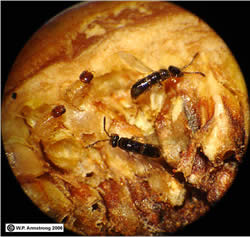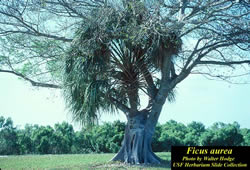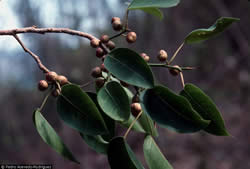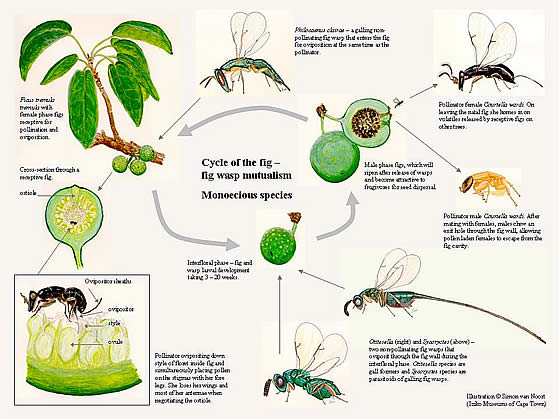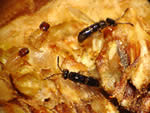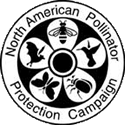USDA Forest Service Celebrating Wildflowers
|
|
|
Fig Wasps
By Beatriz Moisset Fig trees have no visible flowers. At first one might think that they are wind pollinated. Who would visit such an unattractive non-flower? A fig is actually the stem of an inflorescence, very enlarged and fleshy, that surrounds the tiny flowers inside. The crunchy little things that you notice when eating a fig are the seeds, each corresponding to one flower. Such a unique flower requires a unique pollinator. All fig trees are pollinated by very small wasps of the family Agaonidae. Fig trees are tropical plants with numerous species around the world. There are just two species native to the United States: the Florida strangler fig (Ficus aurea) and the shortleaf fig also called giant bearded fig or wild banyan tree (Ficus citrifolia). Each requires the services of one species of wasps. These tiny wasp pollinators are so small and insignificant and so well hidden most of their lives that they go unnoticed, thus they don’t have a common name, only a scientific one. Both are closely related and belong to the same genus: Pegoscapus. The strangler fig is pollinated by Pegoscapus mexicanus and the shortleaf fig by Pegoscapus tonduzi. When the female flowers inside the immature fruit are ready for pollination the fig emits an enticing aroma that attracts only female wasps of the specific type for that tree. The wasp finds the fig by its scent and struggles to get inside through the small opening at the end of the fig. It is such a tight passage that the wasp usually loses its wings and pieces of antennae. It does not matter because it will never need them again. It runs around the interior of the fruit visiting many flowers, laying its eggs inside the future seeds that will nourish its progeny and also spreading the pollen collected from the previous fig where it was born. This pollen will allow all seeds to grow, not just the ones where it has deposited eggs. The ovary of some flowers is safely out of reach of the wasp, so it can’t lay its eggs in them and those seeds can reach maturity. Having fulfilled her life's mission the female wasp dies inside the fig. The eggs become grubs that grow inside the seeds. After completing their full development in a few weeks they emerge from inside the seeds. The males emerge first and start looking for females to mate with. They are smaller than the females and don’t even have wings; they will never fly. After mating they, like their mother, die inside the fig that was their home all their lives. When the females emerge they are already fertilized and ready to find another fig in which to lay their eggs. At this point, the male flowers inside the fig are ripe and loaded with pollen. Before abandoning their home the females will remember to take a supply of such pollen to carry to the next fig.
This incredible partnership requires a very fine tuning and synchronicity on the part of the plant and of the pollinator. It is often mentioned as a fine example of coevolution. For Additional Information
|
|
| NOTE: PDF format links require the Adobe Acrobat Reader to view. | |
| top | Disclaimers | FOIA | Privacy Policy | Quality of Information | Photo Credits & Use |
Location: http://www.fs.fed.us/wildflowers/pollinators/pollinator-of-the-month/fig_wasp.shtml
Last modified: Friday, 09-Jan-2009 13:10:14 EST
